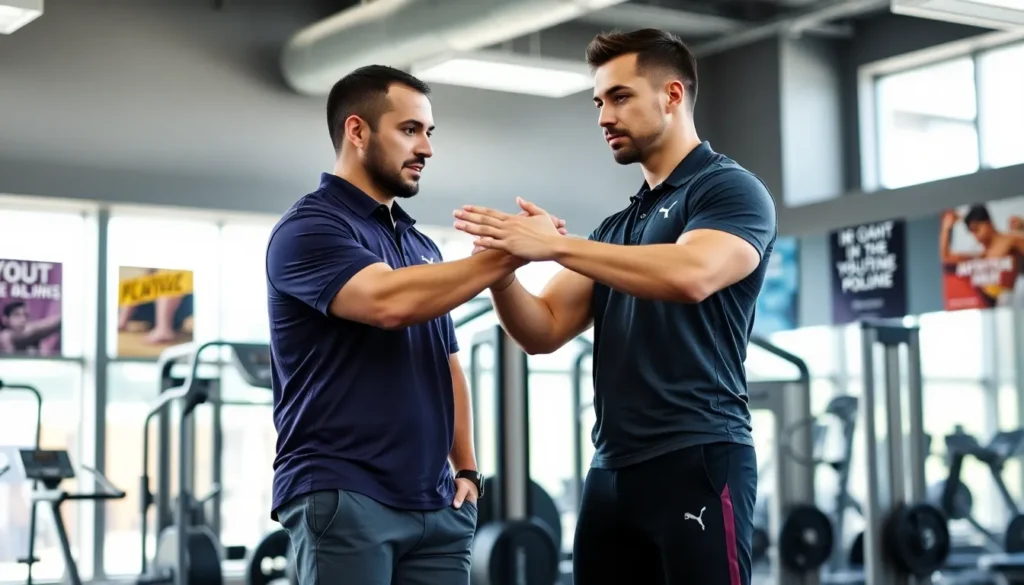Imagine this: you’re about to embark on a fitness journey, and you could use a little guidance. You’ve tried the gym, and those group classes just didn’t cut it. Enter private fitness training, it’s like having your very own personal cheerleader, minus the pom-poms. But seriously, private training isn’t just about lifting weights: it’s an investment in your health and well-being. Ready to dive deeper into the benefits and importance of private fitness training? Let’s get started.
Table of Contents
ToggleUnderstanding Private Fitness Training

Private fitness training involves one-on-one sessions with a certified personal trainer. Unlike group classes, these sessions are tailored specifically to an individual’s unique goals, preferences, and fitness levels. Trainers assess needs and develop customized workout plans to help clients achieve their desired results. This personalized approach ensures that every exercise is relevant and beneficial, maximizing the efficiency of each session.
Benefits of Private Fitness Training
Customized Attention
Private fitness training offers tailored attention that can’t be matched in group settings. Trainers focus exclusively on their clients, addressing areas of concern and optimizing workouts.
Flexible Scheduling
Clients choose their training times, making it easier to fit fitness into busy lifestyles. Early bird or night owl? No problem.
Increased Motivation
Having a trainer makes it less tempting to skip workouts. They encourage and challenge clients, keeping motivation high.
Enhanced Technique
Proper form is crucial in fitness to avoid injuries. Trainers provide immediate feedback, ensuring exercises are performed correctly and safely.
Choosing the Right Private Trainer
Selecting the right trainer can feel overwhelming, but it doesn’t have to be. Here are some key points to consider:
Qualifications and Certifications
Look for trainers certified by reputable organizations. They should have a solid understanding of exercise science, nutrition, and tailored program design.
Personal Style
Each trainer has their unique style. Some focus on strict discipline while others might be more encouraging and friendly. Decide what approach resonates best.
Specializations
Is there a specific fitness goal in mind? Whether it’s bodybuilding, weight loss, or injury rehabilitation, find a trainer with expertise in that area.
Reviews and Recommendations
Don’t hesitate to ask for references or check online reviews. Personal experiences from other clients can provide valuable insights.
Creating a Personalized Fitness Plan
An effective fitness plan can be a game changer. Here’s how to create one:
Assess Current Fitness Level
Every plan should begin with an assessment to understand one’s current physical condition. This helps in setting realistic and achievable goals.
Set Specific Goals
Are you aiming to lose weight, build muscle, or improve overall health? Clear goals can help shape the training program effectively.
Plan for Progression
An effective plan isn’t static. It should evolve as strength and stamina improve. Gradually increasing the intensity or complexity of workouts is essential for continuous progress.
Include Nutrition Guidance
Fitness isn’t just about exercise: nutrition plays a significant role. A good trainer can help provide simple dietary recommendations to complement the workout plan.
The Role of Accountability in Private Training
Accountability is one of the most significant benefits of private fitness training. Here’s why it matters:
Consistency
Having set appointments with a trainer promotes a higher level of commitment. It encourages regular attendance and reduces excuses.
Regular Check-ins
Trainers regularly assess progress, which helps clients remain focused on their goals. Celebrating small wins keeps spirits high.
Support System
Trainers not only provide guidance but also emotional support during challenging times. Knowing someone believes in their potential can motivate clients to push through obstacles.
Navigating Common Challenges in Private Fitness Training
Every fitness journey comes with challenges. Here’s how to tackle them:
Time Management
Finding time to train can be tough. Scheduling sessions during less busy times can alleviate this issue.
Adapting to Physical Limitations
Injuries or past medical conditions shouldn’t hinder progress. Trainers can adapt exercises to suit individual capabilities, ensuring safety while still delivering results.
Staying Motivated
Hitting a plateau? It’s common. Regularly switching workout routines or trying new exercises can keep things fresh and engaging.
Budget Constraints
Private training can seem pricey, but many gyms offer package deals that lower costs. Exploring small group sessions can also provide the benefits of personal training without very costly.













